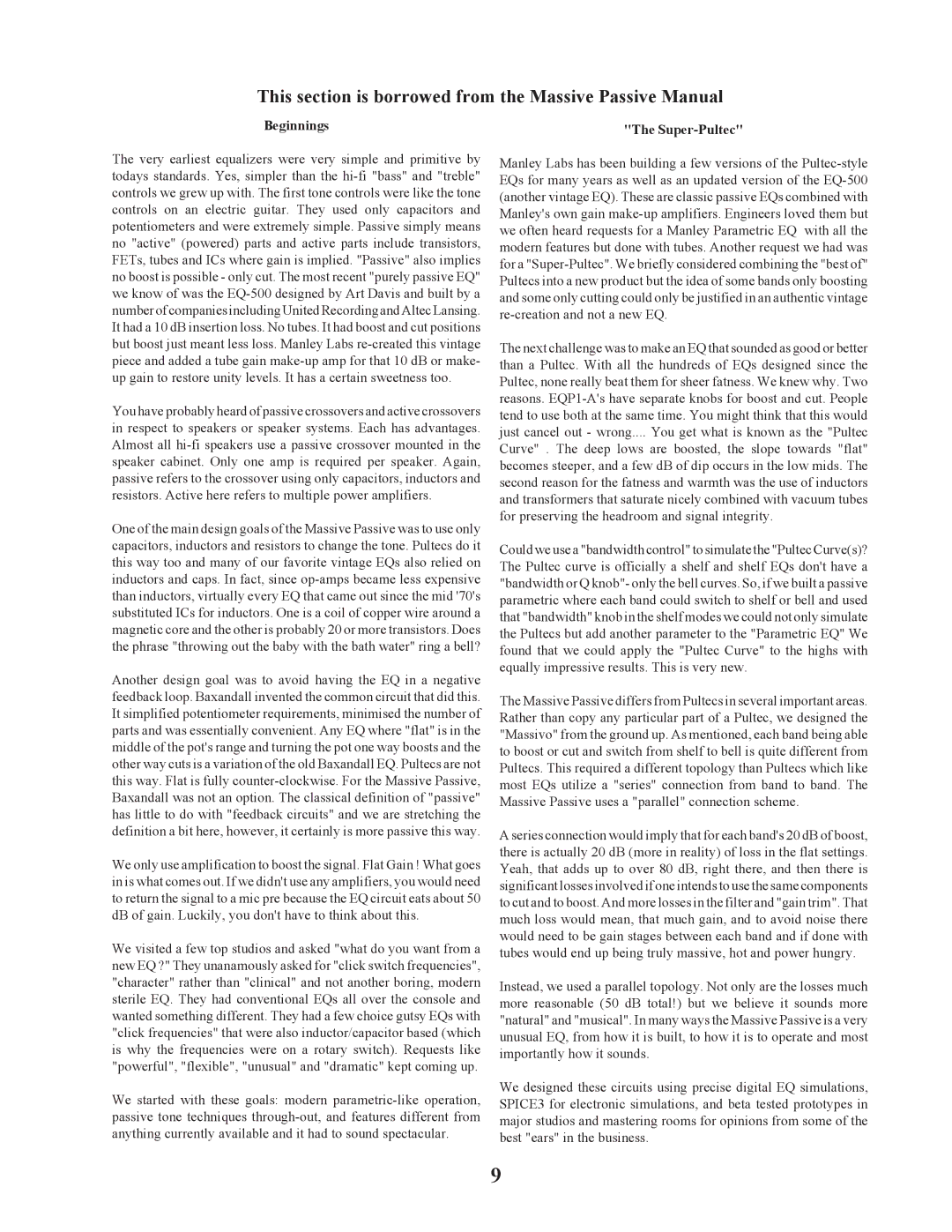This section is borrowed from the Massive Passive Manual
Beginnings | "The |
The very earliest equalizers were very simple and primitive by todays standards. Yes, simpler than the
You have probably heard of passive crossovers and active crossovers in respect to speakers or speaker systems. Each has advantages. Almost all
One of the main design goals of the Massive Passive was to use only capacitors, inductors and resistors to change the tone. Pultecs do it this way too and many of our favorite vintage EQs also relied on inductors and caps. In fact, since
Another design goal was to avoid having the EQ in a negative feedback loop. Baxandall invented the common circuit that did this. It simplified potentiometer requirements, minimised the number of parts and was essentially convenient. Any EQ where "flat" is in the middle of the pot's range and turning the pot one way boosts and the other way cuts is a variation of the old Baxandall EQ. Pultecs are not this way. Flat is fully
We only use amplification to boost the signal. Flat Gain ! What goes in is what comes out. If we didn't use any amplifiers, you would need to return the signal to a mic pre because the EQ circuit eats about 50 dB of gain. Luckily, you don't have to think about this.
We visited a few top studios and asked "what do you want from a new EQ ?" They unanamously asked for "click switch frequencies", "character" rather than "clinical" and not another boring, modern sterile EQ. They had conventional EQs all over the console and wanted something different. They had a few choice gutsy EQs with "click frequencies" that were also inductor/capacitor based (which is why the frequencies were on a rotary switch). Requests like "powerful", "flexible", "unusual" and "dramatic" kept coming up.
We started with these goals: modern
Manley Labs has been building a few versions of the
The next challenge was to make an EQ that sounded as good or better than a Pultec. With all the hundreds of EQs designed since the Pultec, none really beat them for sheer fatness. We knew why. Two reasons.
Curve" . The deep lows are boosted, the slope towards "flat" becomes steeper, and a few dB of dip occurs in the low mids. The second reason for the fatness and warmth was the use of inductors and transformers that saturate nicely combined with vacuum tubes for preserving the headroom and signal integrity.
Could we use a "bandwidth control" to simulate the "Pultec Curve(s)? The Pultec curve is officially a shelf and shelf EQs don't have a "bandwidth or Q knob"- only the bell curves. So, if we built a passive parametric where each band could switch to shelf or bell and used that "bandwidth" knob in the shelf modes we could not only simulate the Pultecs but add another parameter to the "Parametric EQ" We found that we could apply the "Pultec Curve" to the highs with equally impressive results. This is very new.
The Massive Passive differs from Pultecs in several important areas. Rather than copy any particular part of a Pultec, we designed the "Massivo" from the ground up. As mentioned, each band being able to boost or cut and switch from shelf to bell is quite different from Pultecs. This required a different topology than Pultecs which like most EQs utilize a "series" connection from band to band. The Massive Passive uses a "parallel" connection scheme.
A series connection would imply that for each band's 20 dB of boost, there is actually 20 dB (more in reality) of loss in the flat settings. Yeah, that adds up to over 80 dB, right there, and then there is significant losses involved if one intends to use the same components to cut and to boost. And more losses in the filter and "gain trim". That much loss would mean, that much gain, and to avoid noise there would need to be gain stages between each band and if done with tubes would end up being truly massive, hot and power hungry.
Instead, we used a parallel topology. Not only are the losses much more reasonable (50 dB total!) but we believe it sounds more "natural" and "musical". In many ways the Massive Passive is a very unusual EQ, from how it is built, to how it is to operate and most importantly how it sounds.
We designed these circuits using precise digital EQ simulations, SPICE3 for electronic simulations, and beta tested prototypes in major studios and mastering rooms for opinions from some of the best "ears" in the business.
9
